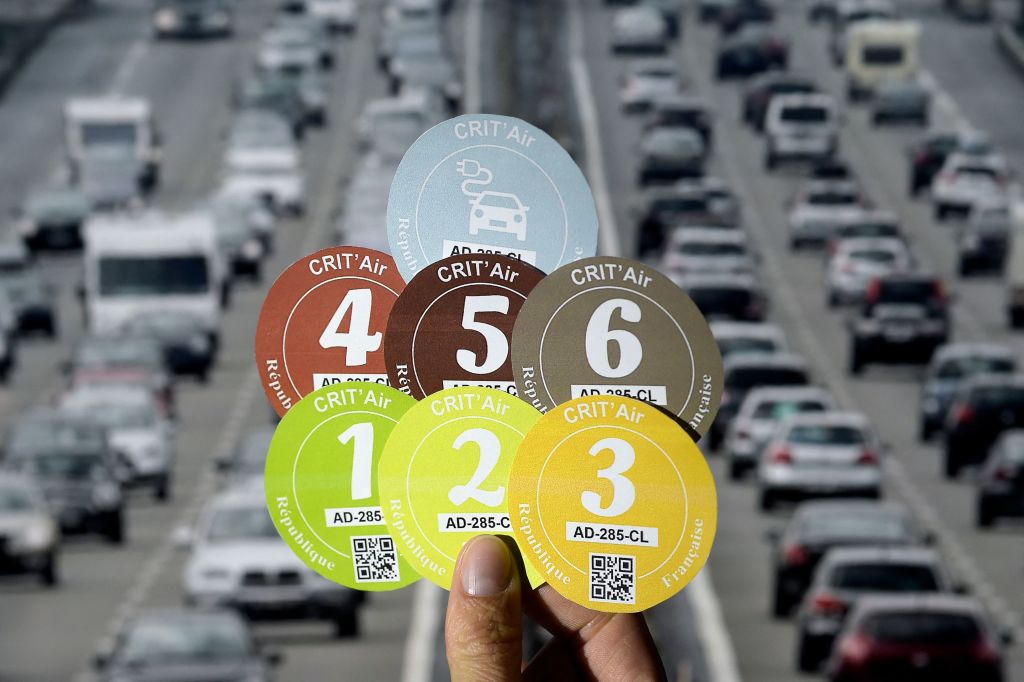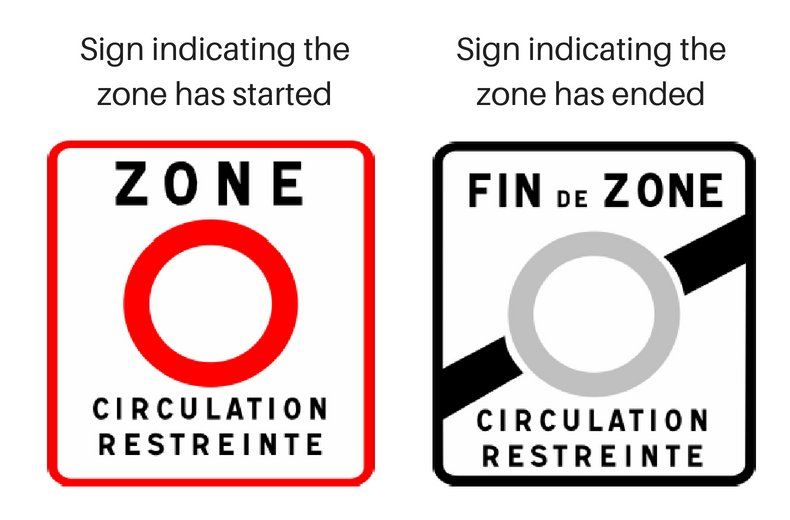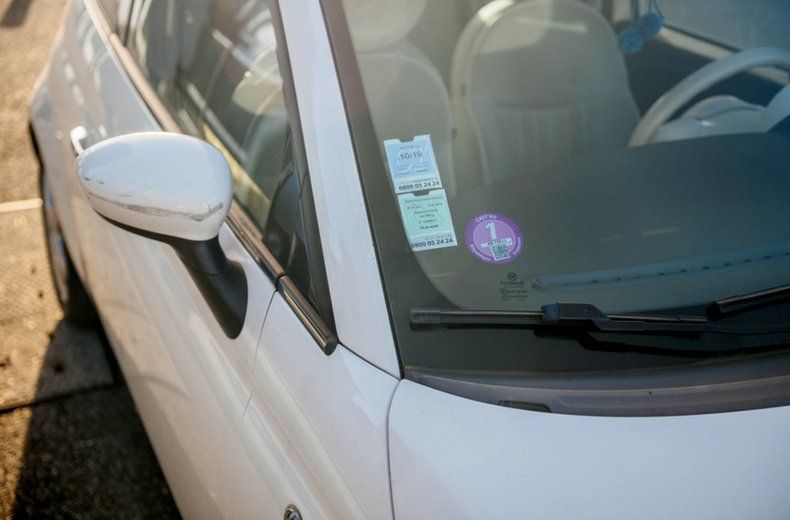Crit'Air stickers are used to identify the vehicle’s emissions levels and, in some cases, restrict its access in order to improve air quality.
British drivers heading to France are advised that driving without a sticker, called a Crit'Air vignette – which costs just €3.81 (including postage) per vehicle – makes them culpable for an on-the-spot fine of up to €180.
To make sure you’re as clued up as possible about all things Crit’Air before your trip to France, here’s everything you need to know.
What are Crit'Air vignettes (French 'clean air' stickers)?

French clean air stickers – called Crit’Air vignettes – are used to identify a vehicle’s air pollutant emissions. The least polluting vehicles are generally allowed to circulate (be driven) more freely than those that emit more pollutants. A sticker covers the vehicle for its entire lifetime, and is based on the vehicle's Euro emissions standard.
There are six categories in the Crit’Air vignette system. These range from green for the cleanest through to dark grey for the dirtiest:
Crit'Air sticker categories
- Crit’Air 0/E - for zero emission electric and hydrogen vehicles - green sticker
- Crit’Air 1 - for plug-in hybrid vehicles and Euro 5, 6 petrol vehicles - purple sticker
- Crit’Air 2 - for vehicles that conform to the Euro 4 petrol vehicles, and Euro 5, 6 diesel vehicles - yellow sticker
- Crit’Air 3 - for vehicles that conform to the Euro 2, 3 petrol vehicles and Euro 4 diesel vehicles - orange sticker
- Crit’Air 4 - for vehicles that conform to the Euro 3 diesel vehicles - burgundy sticker
- Crit’Air 5 - for vehicles that conform to the Euro 2 diesel vehicles - dark grey sticker
Why have Crit'Air stickers been introduced in France?
The system has been introduced by the French government as a way to reduce harmful vehicle emissions in areas where air quality is poorest, such as larger towns and cities.
In these areas, certain vehicles can be refused entry based on the Crit’Air sticker displayed on the windscreen – either all the time or on certain days where air pollution levels are dangerously high.
There are currently two different types of government-defined low emissions zones in France:
- Permanent low-emission zones (known as ZCR – Zone à Circulation Restreinte)
- Temporary emergency low-emissions zones (known as ZPA – Zone de la Protection de l’Air)
In addition, certain French towns and cities now have emergency schemes that can restrict certain vehicles in the event of particularly high pollution.
If driving in any of these zones, a Crit’Air sticker should be affixed to the right-hand side of the car’s windscreen and should be clearly visible at all times.
Do I need a Crit’Air vignette?
All eligible vehicles need to display a Crit’Air vignette on their windscreen to be able to drive and park in restricted traffic zones, such as permanent low-emissions zones and emergency low-emissions zones.
Not all vehicles are eligible for the vignettes. Cars registered before January 1997 and motorbikes and scooters registered before June 2000 are ineligible, and cannot be driven at all where restrictions apply.
Restrictions are also in place for trucks and buses registered before 2001.
Check your vehicle's Euro emissions standard to find out which sticker you'll need.

Instant cover available
• 24/7 rescue at the roadside
• Help to get home if your vehicle can't be fixed
• 5 star Defaqto rated cover

Which towns and cities in France need a Crit’Air sticker?
French low emission zones (ZCRs)
Permanent low emissions zones (known as ZCRs) restrict access (both for driving and parking) to certain vehicles based on their Crit’Air vignette, only allowing access for those displaying a certain category.
These restrictions are in place permanently (usually between certain hours and/or on certain days) and all vehicles seeking entry will need to physically display a sticker regardless of their category, or risk landing a fine.
As of December 2024, ZCRs that might affect drivers arriving from the UK are currently implemented in the following locations in France:
- Aix-Marseille-Provence region
- Bordeaux
- Clermont-Ferrand
- Grenoble
- Lille
- Lyon
- Nice
- Marseille
- Montpellier
- Paris
- Reims
- Rouen
- Strasbourg
- Saint-Etienne
- Toulouse
Paris low-emissions zone - Crit’Air Paris
The French capital actually has two permanent low-emissions zones in place – the Greater Paris ZCR and the Central Paris ZCR.
The Central Paris ZCR (also known as the City of Paris ZCR) was France’s first low-emissions zone. The ZCR was introduced back in September 2015 and currently covers the entire area within the Boulevard Périphérique ring-road.
From July 2023, more stringent rules have been introduced in the ZCR, meaning that only vehicles displaying Crit’Air vignettes E, 1 or 2 are allowed to enter the city between 0800 and 2000, Monday to Friday. From January 2024, the scheme becomes more restricted with all diesel vehicles set to be banned from entering and only vehicles displaying Crit'Air E or 1 vignettes being permitted. A zero-emissons zone is planned for 2030.
The Greater Paris ZCR (also known as a ZPE - Zone à Faibles Emissions) is a permanent low-emissions zone established in July 2019 that largely corresponds to the area within the city’s A86 ‘outer’ ring road.
In participating areas, only vehicles displaying Crit’Air vignettes E, 1 and 2 are allowed to enter between 0800 and 2000 from Monday to Friday. From 2024, diesel vehicles are banned and only cars with Crit'Air 1 vignettes will be valid.
French emergency low emission zone (ZPA)
As opposed to ZCRs, emergency low emissions zones (known as ZPAs) are temporary restrictions imposed on certain vehicles. These are implemented in certain locations when there is a risk of dangerously high air pollution levels.
These areas tend to be significantly larger than the permanent zones, and all vehicles must display a vignette when public announcements dictate that restrictions are in place, or face a fine.
There are currently the areas where emergency low emission zones are implemented during certain conditions:
France ZPA zones
- Paris
- Annecy
- Chambery
- Arve Valley
- Côte d’Or/Dijon
- Creuse/Guéret
- Deux-Sèvres/Niort
- Drôme/Valence
- Eure-et-Loir/Chartres
- Gers/Auch
- Gironde/Bordeaux
- Grenoble
- Haute-Savoie/Annecy
- Hérault/Montpelier
- Isère/Grenoble
- Lille
- Loiret/Orléans
- Lyon
- Maine-et-Loire
- Marseille
- Puy-de-Dome/Clermont Ferrand
- Pyrénées-Atlantiques
- Rennes
- Savoie/Chambery
- Strasbourg
- Toulouse
- Vendée/La Rouche-sur-Yon
- Vienne/Poitiers
However, this situation could change quickly as more cities and departments introduce low-emission zones in response to weather conditions, so check the Urban Access Regulations website before setting off.
How do I know I'm driving into a low emissions zone in France?
The signs below indicate where a ZCR starts and finishes:

How much are Crit'Air vignettes?

The cost of a Crit’Air vignette varies depending on where you buy one. Within France, the stickers cost €3.81 (including postage). International postage will cost more.
Be aware: The French government warns of third-party scam websites that significantly overcharge unsuspecting motorists looking to buy a vignette, so be vigilant and only use the official Crit’Air website when purchasing.
Driving in France Kit from £25.99
Did you know you could be fined up to €530 for not carrying the right kit with you in France?


How do I get a Crit’Air sticker?
You should apply online for a Crit’Air vignette on the official French government website.
In order to apply, research your car's European Emissions Standard using our helpful table but if you’re still unsure contact your vehicle manufacturer.
You’ll also need to upload an image or scan of your vehicle's V5C registration form. This must be uploaded in JPEG, PNG or PDF format and the file size must be under 400KB.
Be aware: The ordering process of a vignette can take up to six weeks so make sure you factor this in before you travel and plan accordingly ahead of time.
Where can I buy a Crit’Air emissions sticker in France?
If you're driving from the UK in a UK-registered vehicle, you won’t be able to buy in France. You must order your sticker direct from the official French government website and ensure it's displayed before you leave for France.
What happens if I don't buy a Crit'Air vignette?
Fines of between €68 and €180 are in place for vehicles that don't display an appropriate sticker and/or are driven in restricted zones when they shouldn't.
The RAC understands that around one-in-10 French vehicles are too old to get a sticker – with certain older models not even assigned a category. These cars are not permitted to drive in Paris between 8am and 8pm, Monday to Friday.
These include cars registered before 1997, motorbikes and scooters registered before June 2000, and trucks and buses from before 2001 – the main offenders in terms of emissions.
If you're driving to France make sure to read our driving in France advice page to brush up on other law changes and find out exactly what documents you need to take with you. It's worth purchasing European breakdown cover before your journey, which will cover you if your vehicle breaks down in France.
How long does a Crit'Air sticker last?
A Crit'Air vignette is valid for the lifetime of the vehicle. This means that as long as the sticker is legible, it's valid.
Are you thinking of driving to France this year? Don't forget to purchase a European Driving Kit from the RAC Shop, including everything you need to stay on the right side of the law.
Crit'Air frequently asked questions
- What vehicles are affected by Crit'Air?
The Crit’Air system applies to all vehicles and affects both French motorists and foreign-registered vehicles. All vehicles need to display a vignette to drive and park in the zones restricted by a ZCR or ZPA.
Not all vehicles are eligible for a vignette. Cars registered before January 1997 and motorbikes and scooters registered before June 2000 are ineligible and cannot be driven at all where restrictions apply.
Restrictions are also in place for trucks and buses registered before 2001.
- Do I need an emissions certificate to drive in France?
Whether you need an emissions certificate (a Crit’Air vignette) will largely depend on where you’re driving within France. However, with an increasing number of cities and departments introducing temporary low-emissions zones in periods of dangerously high air pollution, it may be worthwhile to invest in a Crit’Air vignette ahead of time.
- Do I need a permit to drive in Paris?
Yes, you will need a Crit’Air sticker to drive in Paris. Central Paris is covered with a permanent low-emissions zone (ZCR) that means all vehicles need to display a Crit’Air vignette to be allowed entry during certain times. Any driver failing to display a vignette faces a fine, regardless of their vehicle’s emissions.
In addition to this, Paris is also covered with a temporary low-emissions zone (ZPA), meaning certain vehicles not displaying the correct Crit’Air vignette could be banned from entry during times of dangerously high air pollution.
- Do I need a permit to drive in Lyon?
Yes, you should apply for a Crit’Air vignette if you’re planning on driving in Lyon as the city is covered by a temporary low-emissions zone (ZPA) which means that during periods of dangerously high air pollution vehicles not displaying the permitted Crit’Air vignettes face fines.
- Do I need a Crit’Air sticker for Disneyland Paris?
Whether you actually require a vignette will largely depend on your route to the resort and whether it takes you through any permanent (ZCR) or temporary (ZCR) low-emissions zones on the way. Disneyland Paris itself is not located within one of these zones, but you may pass through one of the Greater Paris low-emissions zones in which case you will need a vignette.
All motorists heading to France should apply for a vignette just to be on the safe side and avoid any unwanted fines that could ruin your day while on holiday.
- Do I need a Crit’Air sticker for France?
With an increasing number of cities and departments introducing temporary low-emissions zones in periods of dangerously high air pollution, it’s a good idea to invest in a Crit’Air vignette ahead of time and avoid getting caught out.
- Are diesel cars allowed in Paris?
From 1 July 2019, diesel cars made earlier than 2006 will be banned from Paris. The ban applies on weekdays between 8am and 8pm to any vehicles carrying the Crit’Air 4 stickers and will affect light trucks as well as some older diesel cars and motorbikes. This rule applies to all vehicles, including those from the UK.
All vehicles displaying Crit’Air vignettes E, 1, 2 and 3 are allowed to enter the city unless blocked by temporary restrictions caused by high levels of air pollution.
- Where can I buy a Crit’Air sticker in the UK?
If you’re in the UK, and going to drive to France in a UK-registered vehicle, you can buy a Crit’Air sticker from the official French Government website.

Instant cover available
• 24/7 rescue at the roadside
• Help to get home if your vehicle can't be fixed
• 5 Star Defaqto rated cover











